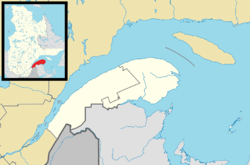Notre-Dame-des-Sept-Douleurs, Quebec
Notre-Dame-des-Sept-Douleurs | |
|---|---|
 chemin de l'Île | |
 Location within Rivière-du-Loup RCM | |
| Coordinates: 48°00′N 69°27′W / 48.000°N 69.450°W[1] | |
| Country | Canada |
| Province | Quebec |
| Region | Bas-Saint-Laurent |
| RCM | Rivière-du-Loup |
| Constituted | 1 January 1874 |
| Government | |
| • Mayor | Louise Newbury |
| • Federal riding | Montmagny—L'Islet—Kamouraska—Rivière-du-Loup |
| • Prov. riding | Rivière-du-Loup-Témiscouata |
| Area | |
• Total | 142.85 km2 (55.15 sq mi) |
| • Land | 11.53 km2 (4.45 sq mi) |
| Population | |
• Total | 71 |
| • Density | 6.2/km2 (16/sq mi) |
| • Pop 2016-2021 | |
| • Dwellings | 117 |
| Time zone | UTC−5 (EST) |
| • Summer (DST) | UTC−4 (EDT) |
| Postal code(s) | |
| Area code(s) | 418 and 581 |
| Highways | No major routes |
| Website | www |
Notre-Dame-des-Sept-Douleurs (French pronunciation: [nɔtʁədam de sɛt dulœʁ], meaning "Our Lady of the Seven Sorrows") is an island municipality in the Bas-Saint-Laurent region of Quebec, Canada, part of the Rivière-du-Loup Regional County Municipality. It is located on and contiguous with Île Verte (French for "Green Island") in the Estuary of St. Lawrence, about 20 kilometres (12 mi) north-east of Rivière-du-Loup. The name Île Verte was given in 1621 by Samuel de Champlain written "Isle Verte".[4]
With a population of only 71 persons, Notre-Dame-des-Sept-Douleurs is one of the smallest municipalities in Canada. It is home to the oldest lighthouse in Quebec (built in 1809).[1]
The main economic activities are fishing and tourism. Many fish smokehouses are present on the island. In addition to the oldest lighthouse in Quebec, its pastoral character, skeleton museum, many artists and heritage homes also attract tourists.[1]
History
[edit]
The island was first mentioned in the Jesuit Reports of 1663 following a shipwreck which forced Henri Nouvel to stay there for about ten days.[1]
On 10 June 1816, half the Nova Scotia Fencibles, some 210 officers and other ranks, together with 48 wives and children, were on board the Archduke Charles when it wrecked near Green Island. Four soldiers, two wives, and two children lost their lives.[citation needed]
In 1874, the municipality was formed out of the parish of La Décollation-de-Saint-Jean-Baptiste on 18 November, which led to its name "Notre-Dame-des-Sept-Douleurs" since this date corresponded to the Day of Our Lady of Sorrows on the liturgical calendar at that time. However the municipality only existed on paper. The community formed in isolation and life on the island was governed by traditional customs, so people had little need for municipal management, which would have been a family affair anyway. Finally on 5 February 1912, the first council meeting took place.[1]
Today, the biggest family to occupy the Island is the Fraser of Scottish Canadian descent.[citation needed]
Geography
[edit]Verte Island is about 2 kilometres (1.2 mi) from the south shore of the St. Lawrence River, roughly 12 kilometres (7.5 mi) long with a maximum width of 1.8 kilometres (1.1 mi). It has a maximum elevation of 60 metres (200 ft).[4]
Demographics
[edit]In the 2021 Census of Population conducted by Statistics Canada, Notre-Dame-des-Sept-Douleurs had a population of 71 living in 46 of its 117 total private dwellings, a change of 97.2% from its 2016 population of 36. With a land area of 11.53 km2 (4.45 sq mi), it had a population density of 6.2/km2 (15.9/sq mi) in 2021.[5]
|
| |||||||||||||||||||||||||||||||||||||||||||||||||||||||||||||||
| Source: Statistics Canada[6] | ||||||||||||||||||||||||||||||||||||||||||||||||||||||||||||||||
Mother tongue (2021):[3]
- English as first language: 0%
- French as first language: 100%
- English and French as first language: 0%
- Other as first language: 0%
Attractions
[edit]Thanks to its isolation, the island has preserved its high-quality architectural heritage, such as the Île-Verte Lighthouse, and a rural landscape from another era that is attracting more and more tourists.
See also
[edit]References
[edit]- ^ a b c d e "Banque de noms de lieux du Québec: Reference number 44874". toponymie.gouv.qc.ca (in French). Commission de toponymie du Québec.
- ^ a b "Répertoire des municipalités: Geographic code 12045". www.mamh.gouv.qc.ca (in French). Ministère des Affaires municipales et de l'Habitation.
- ^ a b c "Notre-Dame-des-Sept-Douleurs, Paroisse (municipalité de) (PE) Census Profile, 2021 Census of Population". www12.statcan.gc.ca. Government of Canada - Statistics Canada. 9 February 2022. Retrieved 29 September 2022.
- ^ a b "Banque de noms de lieux du Québec: Reference number 65683". toponymie.gouv.qc.ca (in French). Commission de toponymie du Québec.
- ^ "Population and dwelling counts: Canada, provinces and territories, and census subdivisions (municipalities), Quebec". Statistics Canada. 9 February 2022. Retrieved 29 August 2022.
- ^ 1996, 2001, 2006, 2011, 2016, 2021 census
External links
[edit]![]() Media related to Notre-Dame-des-Sept-Douleurs at Wikimedia Commons
Media related to Notre-Dame-des-Sept-Douleurs at Wikimedia Commons

